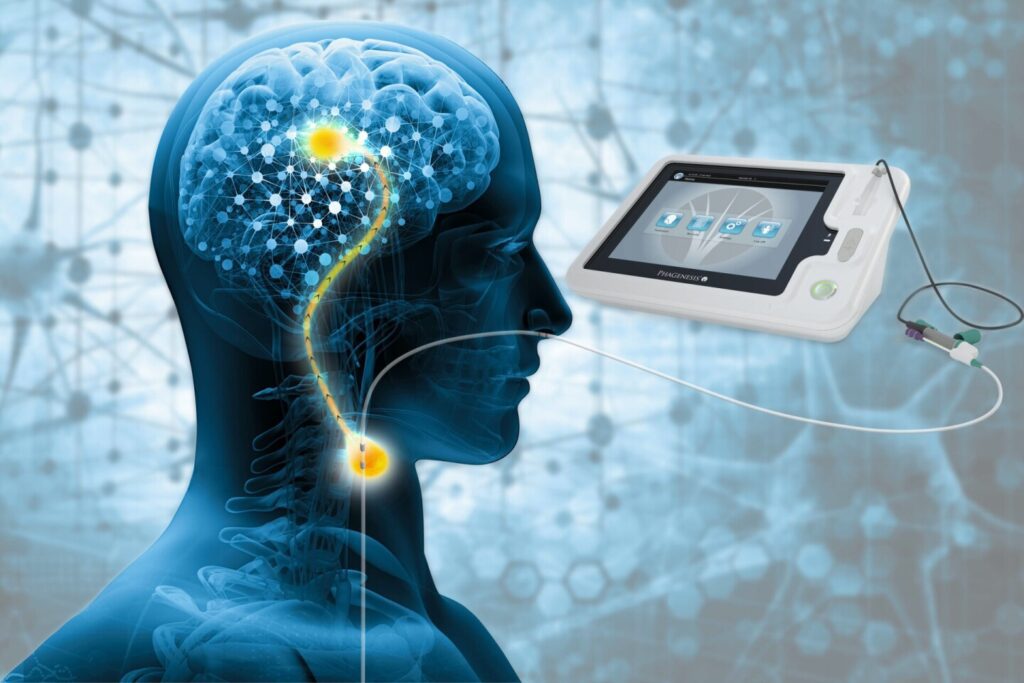Electrical Stimulation and Dysphagia
Non-Surgical Treatment for Facial Paralysis
Physical and occupational therapists have been treating facial paralysis for decades. As early as 1927, physical therapy treatment of Bell’s palsy was advocated using treatment methods that have become “standard” in the decades since. Treatment modalities, originally developed for and successfully used on the extremities, were applied to the face.
Gross facial exercises, massage, electrical stimulation, and prosthetic devices or taping to lift a drooping, flaccid face were the treatments of choice. These non-specific procedures continue to be recommended and practiced today.
Now with knowledge and cutting edge therapy techniques speech pathologists have taken this treatment to a new level. Through the use of muscle specific and muscle isolating exercises, great gains in muscle re-education have improved the speech pathologist’s toolbox.
HISTORY
In past years E-stim has been used for:
- Tremors in Parkinson’s (deep brain stimulation)
- Wound healing
- Pain management
- Reduction of edema
- Muscle enhancement, specifically:
- Increasing ROM
- Improving strength
- Reeducating contraction patterns and timing
- Correcting abnormal muscle tone
E-Stim for treatment of dysphagia was introduced:
- 1975- Marcy Freed developed her protocol while at HillcrestHospitalin Ohio.
- 1999- Teresa Biber in collaboration with PT and Otolaryngology departments while at the Cleveland Clinic in Florida.
Current FDA approved uses for NMES include:
- muscle reeducation
- prevent/retard disuse atrophy
- relax muscle spasm
- increase local blood circulation
- immediate post surgical stimulation of calf muscles to prevent DVT
- maintain or increase ROM
FAQ's
HOW DOES E-STIM WORK?
- Electrical impulses transmitted transcutaneously via 2 electrodes places on the submental area, away from carotid arteries and not directly on larynx.
- Body tissue (muscle) conduct electricity, causing a depolarization of the nerve fibers, thus creating a muscle contraction by dispersing an action potential across the muscle fibers.
-Normal vs. Stimulated muscle contraction:
- Normal muscle contraction occurs when action potential is transferred to the muscle by the nerve. Stimulated muscle contraction occurs as a result of muscle fibers being directly stimulated by the electrical current from the voltage source.
–Muscle Fiber Recruitment
- Type I muscle fibers are recruited first during normal muscle contraction, followed by Type II muscle fibers (swallowing muscles are primarily composed of Type II fibers)
- Recruitment patterns during e-stim are reversed; Type II fibers are recruited first.
-Firing pattern
- Normal muscle contraction is an asynchronous contraction pattern (one fiber relays message to another). This protects against fatigue; when demand on muscle exceeds its capacity, more motor units are recruited… leading to rapid fatigue and the muscle responding by increasing its capacity.
- Stimulated muscle contraction is a synchronous contraction pattern (all muscle fibers within the path of the electrical current are recruited). Fatigue occurs more rapidly, therefore muscle strengthening is promoted and achieved. (increase muscle contraction = increase muscle strength)
TREATMENT USES
- Maintain/strengthen muscle mass during inactive periods
- Maintain/gain ROM: Facilitates laryngeal elevation by strengthening the extrinsic laryngeal muscles (laryngeal muscles are like other skeletal muscles stimulated by PT or OT). Ultimately, airway protection is achieved.
- Facilitate voluntary motor control (swallowing maneuvers)
- Increase sensory awareness (laryngeal/pharyngeal)
- Muscle reeducation – Combined with ‘task specific’ or volitional exercises (i.e., swallowing) recruitment of both type I and type II muscle fibers.
CRITICISM
- stimulated muscle contraction is different (reversed order) from volitional movement and therefore carryover may be limited.
- No efficacy studies, only case studies and anecdotal evidence are suggestive of positive outcomes with use of e-stim.
DYSPHAGIA STATISTICS
- 6-10 million Americans impacted
- 1 out of 17 people affected
- 14% of all hospital patients
- 50% of all nursing home patients
- 33% of all rehab patients
- 22% receiving treatment
- 45-68% mortality rate
GOAL/OBJECTIVE
- Achieve adequate laryngeal elevation
- Pair swallowing with e-stim to reeducate the brain
- Change swallow mechanism not just trigger swallow
Get Free Initial Consultation, Call 561-833-2090
Fees are an estimate only and may be more depending on your situation
MedSpeech, Inc., offers a variety of services for all of your speech-language pathology needs. We specialize in:
We also offer fiberoptic endoscopic evaluation of swallowing (FEES) and videostroboscopy. Call us at (561)-833-2090 or click here to fill out our contact form today!

